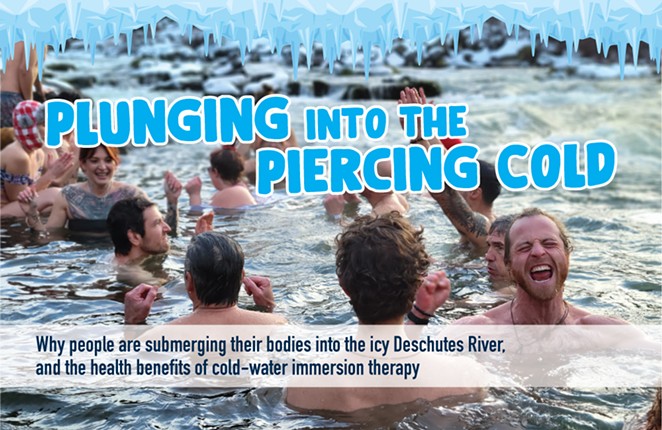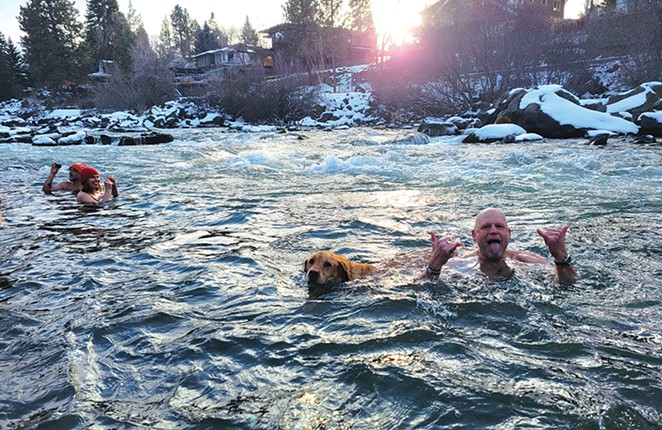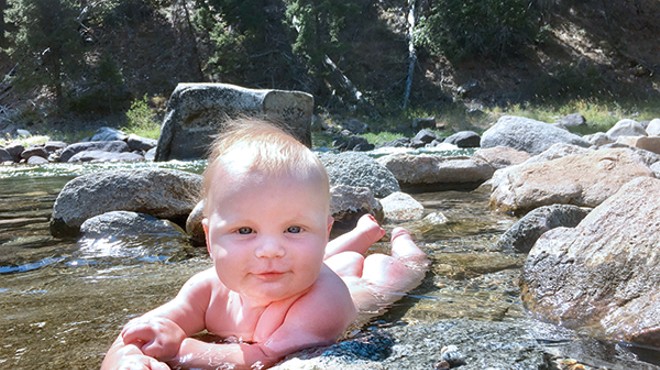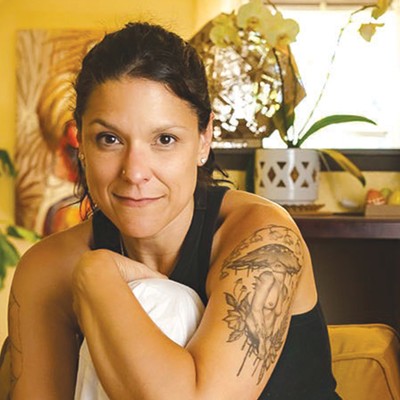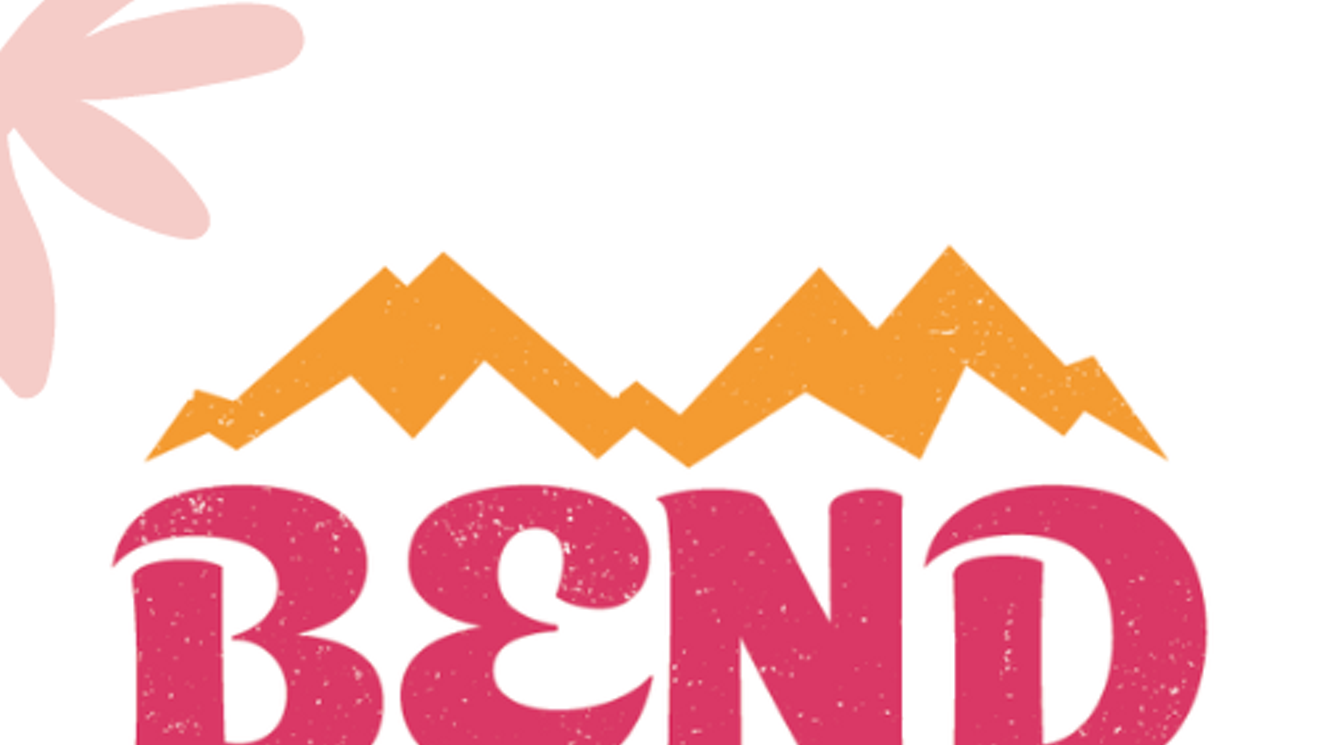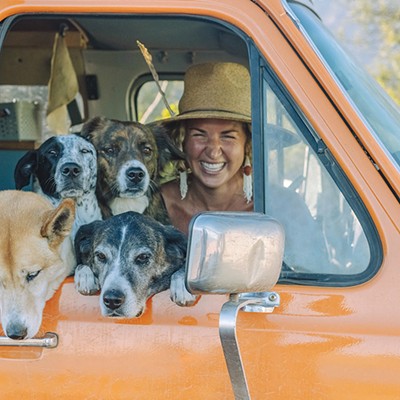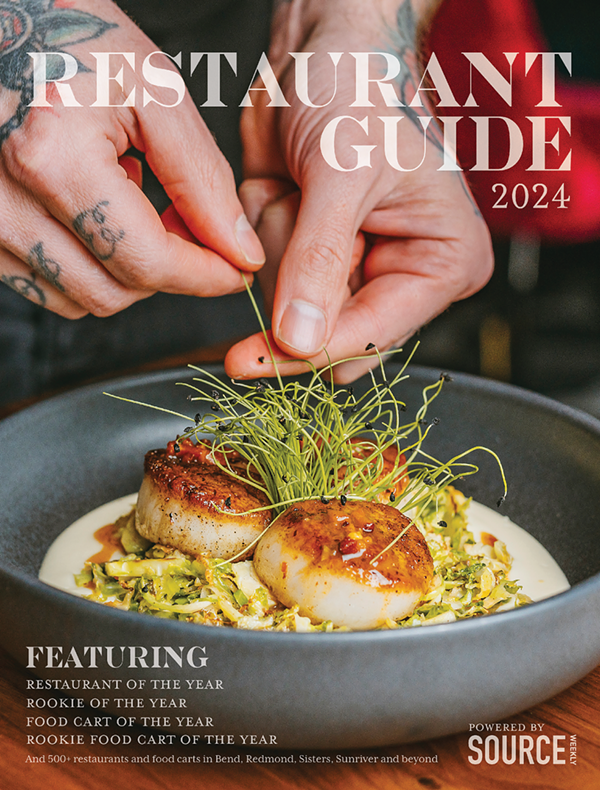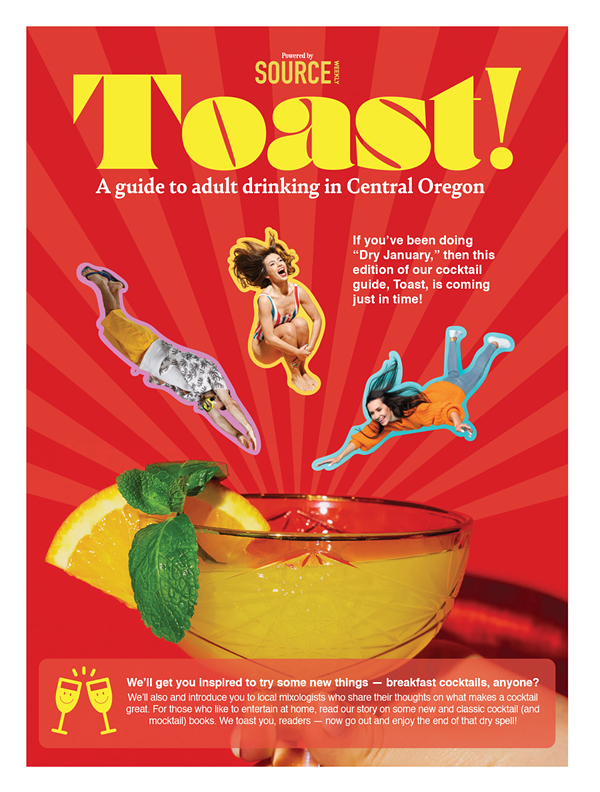"We can do hard things. We can do hard things. We can do hard things." Up to their shoulders in the frigid river waters at Miller's Landing Park, wearing bathing suits and beanies, three women chant together while one woman's watch timer clocks the passing minutes.
Doing the hard thing, plunging — quite literally — into the challenge, is the motivation pulling people into freezing-cold water. Not just an annual polar plunge, many Bend residents are committing themselves to daily, weekly or monthly cold exposure practices year-round, including morning cold showers or icy plunges in lieu of caffeine.
What prompted the cold plunge craze?
Cold bathing and contrast therapy (alternate exposure to cold and hot temperatures) are centuries-old traditions dating back to ancient Egyptians, Greeks and Romans, and Japanese mizugori practices. Popularity of cold-water immersion grew in the U.S. for post workout and sports injury recovery, later expanding when professional athletes like Laird Hamilton started incorporating the Wim Hof method of breathing and cold therapy to improve performance.
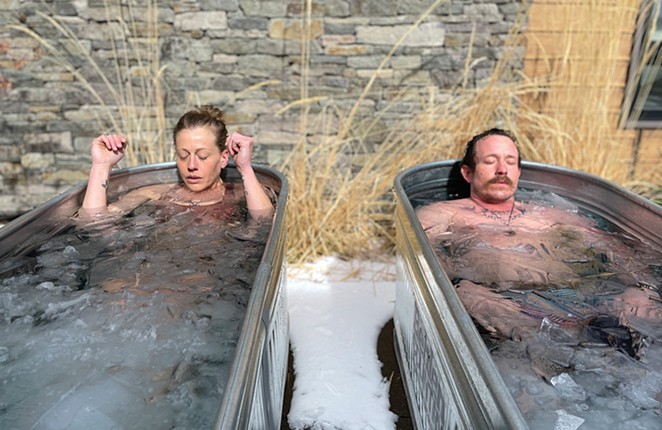
Exposing the body to cold conditions — such as during cold-water immersion or cryotherapy — indirectly stimulates the vagus nerve (part of the parasympathetic nervous system regulating involuntary bodily functions like the immune system and digestion), cueing the body to calm down, maintaining homeostasis, aka optimal functioning. Deep breathing, meditation and singing also activate the vagus nerve.
Additionally, water exerts hydrostatic pressure and when cold, it constricts blood vessels (vasoconstriction), promoting increased blood flow to major organs, helping blood gather and circulate additional nutrients and oxygen to the body.
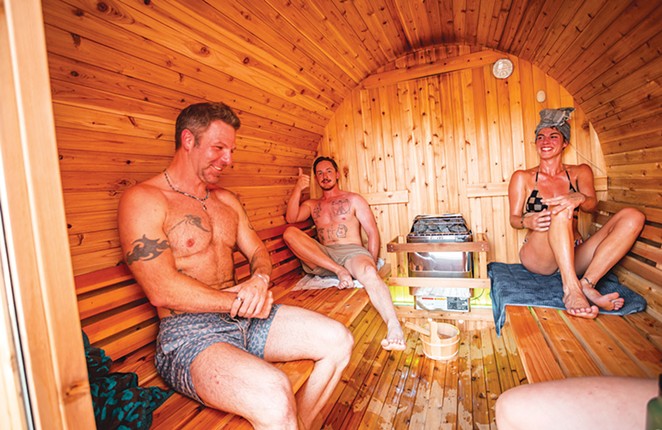
Reported cold plunge benefits include reduced inflammation, stress and anxiety and improved muscle performance, circulation, mood and sleep, according to the Cleveland Clinic. Also, a stronger immune system, according to a study published in 1996. Other benefits include pain relief and increased pain tolerance, boosted confidence, energy, and relaxation. Combined with heat, which causes blood vessels to open (vasodilation), the quick temperature variation induces vascular pumping, which improves healing, reduces inflammation, and promotes quicker recovery.
Whether plunging for physical benefits, mental, or like me, both, people of all ages, shapes, and sizes are flocking to frigid water, partaking in this holistic healing modality touted by many to be a life-changing habit.
The first 60 seconds is the hardest. The key is staying calm. Not such an easy feat when the body is wired to stave off hypothermia, alarming the brain to get warm as soon as possible.
tweet this
"What motivated me initially was just to do something that's hard, something I don't want to do," said Brooke Hausman, who taps into her breath, allowing herself "to get out of the fight or flight response" that happens during a cold plunge. "I try not to think too much about it."
Three minutes is the mark for many cold plungers pursuing the benefits of cold-water therapy in exchange for the grueling hurdle of getting into the water. Most people admit that the hurdle is mental, not necessarily the physical feeling of being cold. It's the fear of being cold. Overcoming that mental barrier means simply getting into the ice water and not overthinking it.
Local yoga instructor, Deanna Kay, confesses before a group cold plunge at First Street Rapids, "I'm kind of dreading it, but I always dread it. The less I think about it the better." When doing an ice bath, she usually stays in for three minutes, but submerging in the river is harder for her, stating that "Even if I just hit a minute, I'm good with that."
The first 60 seconds is the hardest. The key is staying calm. Not such an easy feat when the body is wired to stave off hypothermia, alarming the brain to get warm as soon as possible. Breathing techniques and building mental stamina are the tools for success among avid plungers.
Cold plunging isn't just the chase for a thrill. Often quite the opposite, these wellness- conscious individuals desire a meditative experience, community and the chance to feel great.
For some, it's slipping into a tub full of 36-degree Fahrenheit water. For others, it's wading into a chilly river, alpine lake, icy creek or the cold Pacific Ocean. Most immerse up to their shoulders or neck, leaving heads and hands out of the water, which helps regulate body temperature and finger dexterity post plunge. A rare few will fully submerge before sticking out the bitter cold for another minute, or three, or five.
Being engulfed in bone-chilling water doesn't naturally evoke feelings of meditation, but maybe that's the point. The power of being present, fully connected to self in a state of calm, while enduring conditions that activate the body's survival mechanism is that much more profound.
Sherpa Breathwork and Cold Instructor, and ringleader of the WhatsApp group, Bend Cold Crew, Cameron Larson, wanted to create a new life for himself after divorce and COVID.
"Finding a community with a deep spiritual practice was my purpose and I found it through the amazing yogis (Amber, Kristin and Bridget) at Groove Yoga and my first plunge in the snowy cold river with Phillip Levasseur, who founded Biohacking Bend."
On a snowy, January afternoon in subzero air temps, the stoke was high, energy was up, and music was blasting. Larson announced a two-minute countdown at the tail end of their riverside dance party, then led the 20-plus people into the Deschutes River by bounding off a rock for a full body submersion, matched by two more brave souls who followed suit. Some stayed in for a minute or two, about 15 plungers held out for a full three minutes, and a 10-person, two-minute group hug in the water concluded the event. Water goers swiftly exited the river, dried, changed and headed for their cars.
That first icy dip with Levasseur catapulted Larson and he immediately set out to cold plunge every day for an entire year. He recently completed his 400th consecutive daily cold plunge with a small group, including one woman conquering her first-ever plunge, as ice floated downstream in the 32-degree Fahrenheit water and a 6-degree air temp.
"I've found my body has greatly adapted to the cold and is still steadily tolerating more," Larson said. "My hands and feet recover much faster than last winter, but I would say by my 30th consecutive day I was feeling pretty comfortable." He plans to continue plunging "as long as I'm having fun, as long as it feels good."
Craving camaraderie, Larson eventually started a WhatsApp group, now with over 130 members, rallying others to join his daily cold excursions and also wanting to pay it forward. "[I feel] a deep sense of gratitude to be able to give back and be a positive influence on someone else's life."
Levasseur set out on his own health optimization expedition over two decades ago, pursuing breathwork and cold-plunge techniques to improve performance at work, the gym and overall, in his life. And they worked.
Now, 20 years later and, "after a very profound breathwork experience called a System Reset by [wellness community] NOA|AON," Levasseur said, "I realized I needed to share the experience of breathwork and cold exposure with as many people as I could." This led him to found the Biohacking Bend and Wim Hof Method & Cold Plunge groups here in Bend, facilitating a myriad of breathwork styles like Wim Hof, box breathing, CO2 retention and more, as well as cold and heat exposure hacks. His goal is to help others reach what he believes is an optimal way of living. "When guiding others, there is a strong energy exchange. I tend to feel as though the energy requirement for guiding breathwork is much greater than when practicing it myself. Both, however, leave me with a sense of gratitude and light heartedness." Biohacking Bend events are posted on Meetup, and health optimization hacks are posted to the private Biohacking Bend Facebook and Telegram groups.
Levasseur doesn't plunge daily, and there's caution in doing so, especially for those with certain medical conditions. "I do what my body can handle, and I like encouraging others to both be brave and go for it, but also listen to their bodies and breathe," said Summer Baird, a previously very active outdoorswoman who's healing her body after suffering from Long Covid and now a heart condition.
Cold plunging can overstress the body's cells, and Levasseur, along with Baird, Kay and a host of wellness practitioners and researchers, encourage everyone "to intuitively listen to their body."
Tips from plunging pros!
- Break into the bitter cold slowly, beginning with cold showers if that’s helpful. It’s recommended to gradually increase time immersed in cold water, starting with 20-30 seconds if the water is very cold, and building up from there.
- Several river access points in town make for great winter cold plunging, such as Miller’s Landing Park, Riverbend Park and First Street Rapids Park. During summer, Tumalo Creek remains cold-plunge worthy. Day use areas along the Deschutes River Trail provide a natural cold plunge setting.
- Biohacking Bend and Gather Sauna host contrast therapy events. And bathtubs or large plastic bins can be transformed into ice baths with tap water and lots of ice.
- Don’t over think it. Set an intention. Listen to your body. And breathe.

